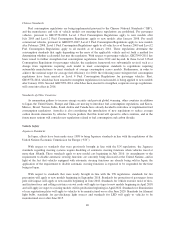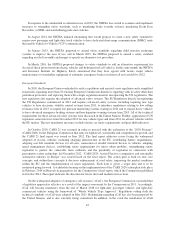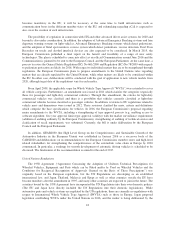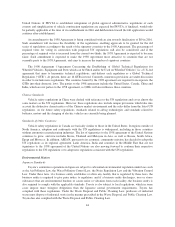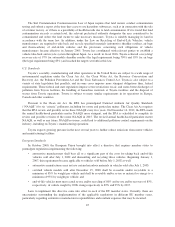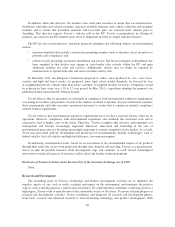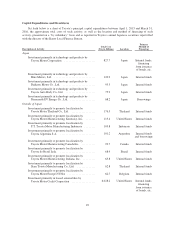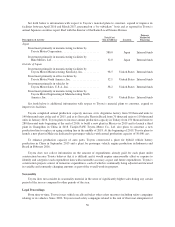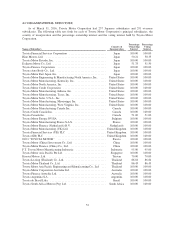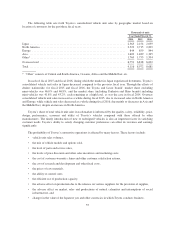Toyota 2015 Annual Report Download - page 51
Download and view the complete annual report
Please find page 51 of the 2015 Toyota annual report below. You can navigate through the pages in the report by either clicking on the pages listed below, or by using the keyword search tool below to find specific information within the annual report.In addition, under this directive, the member states must take measures to ensure that car manufacturers,
distributors and other auto-related economic operators establish adequate used vehicle collection and treatment
facilities and to ensure that hazardous materials and recyclable parts are removed from vehicles prior to
shredding. This directive impacts Toyota’s vehicles sold in the EU. Toyota accommodated, in offering its
products, any measures the EU member states chose to implement in order to comply with this directive.
The EU has also issued directives and made proposals relating to the following subjects on environmental
matters:
• emission standards that include a framework permitting member states to introduce fiscal incentives to
promote early compliance; and
• reform of rules governing automotive distribution and service. The block exemption on distribution has
been amended so that dealers may engage in cross-border sales actively within the EU and open
additional facilities for sales and services. Additionally, dealers may no longer be required by
manufacturers to operate both sales and service facilities side by side.
In December 2011, the European Commission proposed to reduce noise produced by cars, vans, buses,
coaches and light and heavy trucks. As proposed, noise limit values would ultimately be lowered by four
A-weighted decibels for vehicles other than trucks, and three A-weighted decibels for trucks. Compliance would
be achieved in three steps over a 10 to 12 year period. In May 2014, a regulation adopting the proposal was
published in final form in the EU Official Journal.
Toyota believes that its operations are materially in compliance with environmental regulatory requirements
concerning its facilities and products in each of the markets in which it operates. Toyota continuously monitors
these requirements and takes necessary operational measures to ensure that it remains in material compliance
with all of these requirements.
Toyota believes that environmental regulatory requirements have not had a material adverse effect on its
operations. However, compliance with environmental regulations and standards has increased costs and is
expected to lead to higher costs in the future. Therefore, Toyota recognizes that effective environmental cost
management will become increasingly important. Moreover, innovation and leadership in the area of
environmental protection are becoming increasingly important to remain competitive in the market. As a result,
Toyota has proceeded with the development and production of environmentally friendly technologies, such as
hybrid vehicles, fuel cell vehicles and high fuel efficiency, low emission engines.
In addressing environmental issues, based on an assessment of the environmental impact of its products
through their entire life cycles, from production through sales, disposal and recycling, Toyota, as a manufacturer,
strives to take all possible measures from development stage and continues to work toward technological
innovations to make efficient use of resources and to reduce the burden on the environment.
Disclosure of Iranian Activities under Section 13(r) of the Securities Exchange Act of 1934
None.
Research and Development
The overriding goals of Toyota’s technology and product development activities are to minimize the
negative aspects of cars, such as traffic accidents and impact on the environment, and maximize the positive
aspects, such as driving pleasure, comfort and convenience. By achieving these sometimes conflicting goals to a
high degree, Toyota seeks to open the door to the automobile society of the future. To ensure efficient progress in
research and development activities, Toyota coordinates and integrates all research and development phases,
from basic research and advanced research to forward-looking technology and product development. With
46






